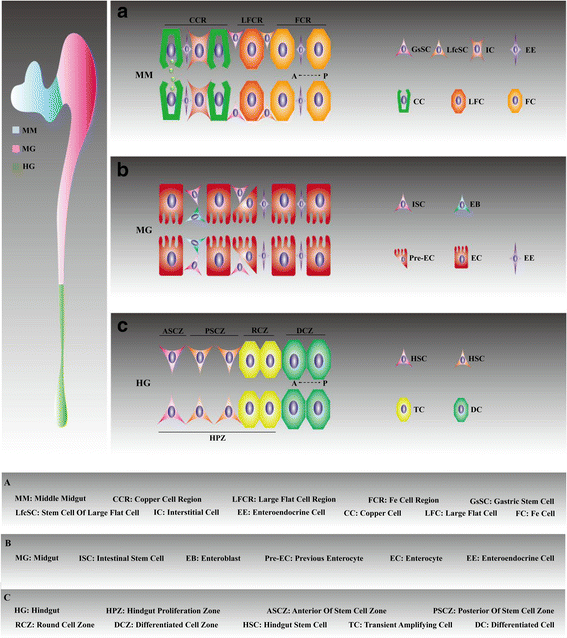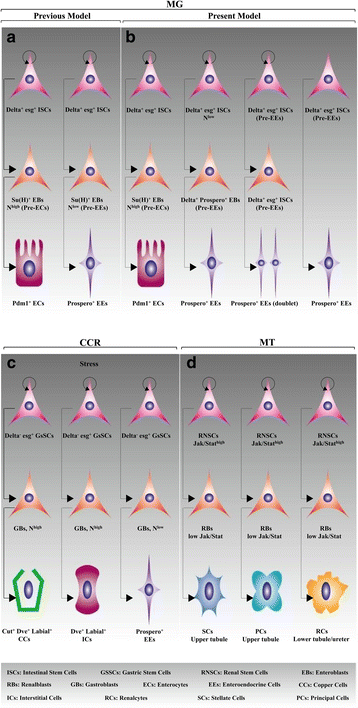Tissue-resident stem cell activity: a view from the adult Drosophila gastrointestinal tract
- PMID: 28923062
- PMCID: PMC5604405
- DOI: 10.1186/s12964-017-0184-z
Tissue-resident stem cell activity: a view from the adult Drosophila gastrointestinal tract
Abstract
The gastrointestinal tract serves as a fast-renewing model for unraveling the multifaceted molecular mechanisms underlying remarkably rapid cell renewal, which is exclusively fueled by a small number of long-lived stem cells and their progeny. Stem cell activity is the best-characterized aspect of mucosal homeostasis in mitotically active tissues, and the dysregulation of regenerative capacity is a hallmark of epithelial immune defects. This dysregulation is frequently associated with pathologies ranging from chronic enteritis to malignancies in humans. Application of the adult Drosophila gastrointestinal tract model in current and future studies to analyze the immuno-physiological aspects of epithelial defense strategies, including stem cell behavior and re-epithelialization, will be necessary to improve our general understanding of stem cell participation in epithelial turnover. In this review, which describes exciting observations obtained from the adult Drosophila gastrointestinal tract, we summarize a remarkable series of recent findings in the literature to decipher the molecular mechanisms through which stem cells respond to nonsterile environments.
Keywords: Drosophila; Gastrointestinal tract; Homeostasis; Proliferation and differentiation; Stem cells.
Conflict of interest statement
Ethics approval and consent to participate
We declare that this is a review article for which no animal or human experiments were conducted. We followed strict ethical rules regarding the compilation of already-published data relevant to the current topic.
Consent for publication
Not applicable.
Competing interests
The authors declare that they have no competing interests.
Publisher’s note
Springer Nature remains neutral with regard to jurisdictional claims in published maps and institutional affiliations.
Figures




Similar articles
-
Gastrointestinal stem cells in health and disease: from flies to humans.Dis Model Mech. 2016 May 1;9(5):487-99. doi: 10.1242/dmm.024232. Epub 2016 Apr 25. Dis Model Mech. 2016. PMID: 27112333 Free PMC article. Review.
-
Simultaneous control of stemness and differentiation by the transcription factor Escargot in adult stem cells: How can we tease them apart?Fly (Austin). 2016 Apr 2;10(2):53-9. doi: 10.1080/19336934.2016.1176650. Epub 2016 Apr 14. Fly (Austin). 2016. PMID: 27077690 Free PMC article.
-
The cellular homeostasis of the gut: what the Drosophila model points out.Histol Histopathol. 2015 Mar;30(3):277-92. doi: 10.14670/HH-30.277. Epub 2014 Oct 8. Histol Histopathol. 2015. PMID: 25293339 Review.
-
The regenerative nidi of the locust midgut as a model to study epithelial cell differentiation from stem cells.J Exp Biol. 2006 Jun;209(Pt 11):2215-23. doi: 10.1242/jeb.02249. J Exp Biol. 2006. PMID: 16709922
-
The role of TGF-beta and Wnt signaling in gastrointestinal stem cells and cancer.Oncogene. 2005 Aug 29;24(37):5775-89. doi: 10.1038/sj.onc.1208924. Oncogene. 2005. PMID: 16123810 Review.
Cited by
-
The Evolution of Extreme Genetic Variability in a Parasite-Resistance Complex.Genome Biol Evol. 2024 Oct 9;16(10):evae222. doi: 10.1093/gbe/evae222. Genome Biol Evol. 2024. PMID: 39391977 Free PMC article.
-
Coordinated repression of pro-differentiation genes via P-bodies and transcription maintains Drosophila intestinal stem cell identity.Curr Biol. 2022 Jan 24;32(2):386-397.e6. doi: 10.1016/j.cub.2021.11.032. Epub 2021 Dec 6. Curr Biol. 2022. PMID: 34875230 Free PMC article.
-
Cohesin controls intestinal stem cell identity by maintaining association of Escargot with target promoters.Elife. 2020 Feb 5;9:e48160. doi: 10.7554/eLife.48160. Elife. 2020. PMID: 32022682 Free PMC article.
-
Insights into regeneration tool box: An animal model approach.Dev Biol. 2019 Sep 15;453(2):111-129. doi: 10.1016/j.ydbio.2019.04.006. Epub 2019 Apr 13. Dev Biol. 2019. PMID: 30986388 Free PMC article. Review.
-
The role of Drosophila microbiota in gut homeostasis and immunity.Gut Microbes. 2023 Jan-Dec;15(1):2208503. doi: 10.1080/19490976.2023.2208503. Gut Microbes. 2023. PMID: 37129195 Free PMC article. Review.
References
Publication types
MeSH terms
LinkOut - more resources
Full Text Sources
Other Literature Sources
Medical
Molecular Biology Databases

